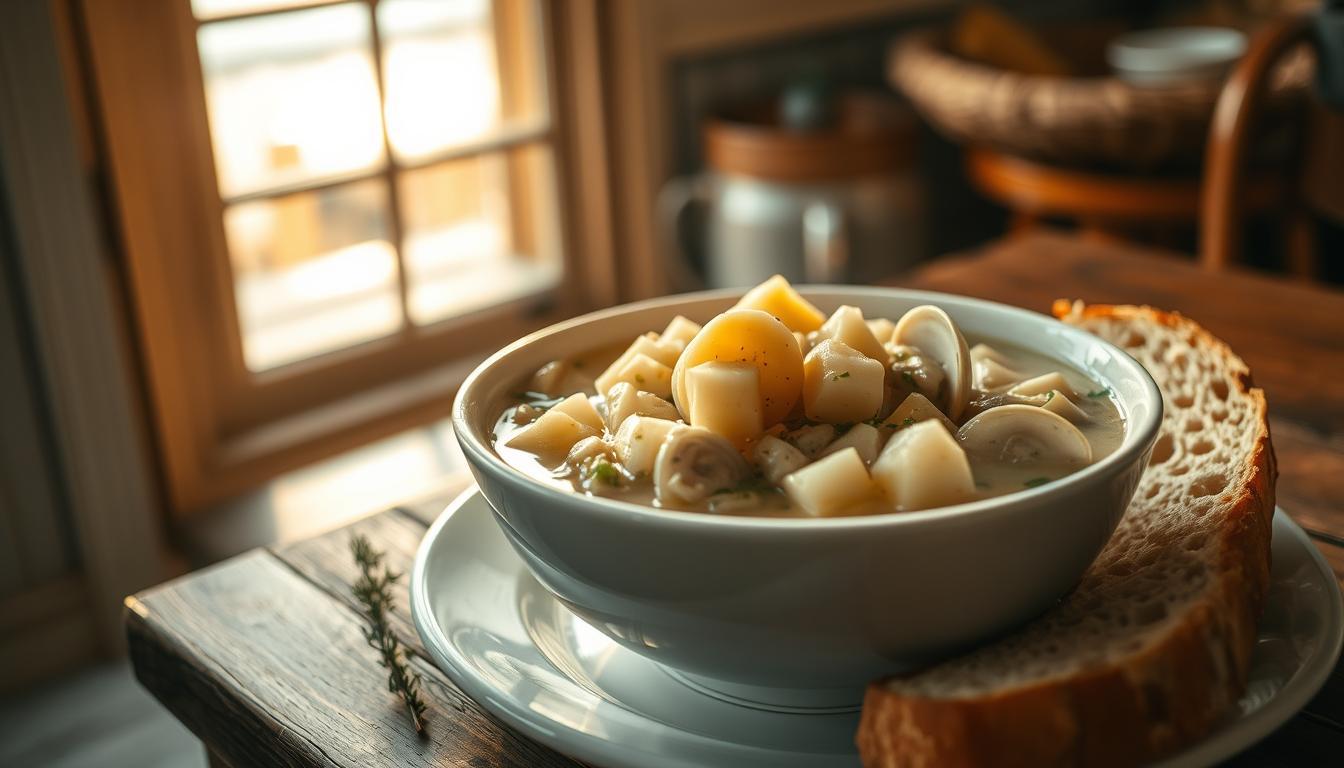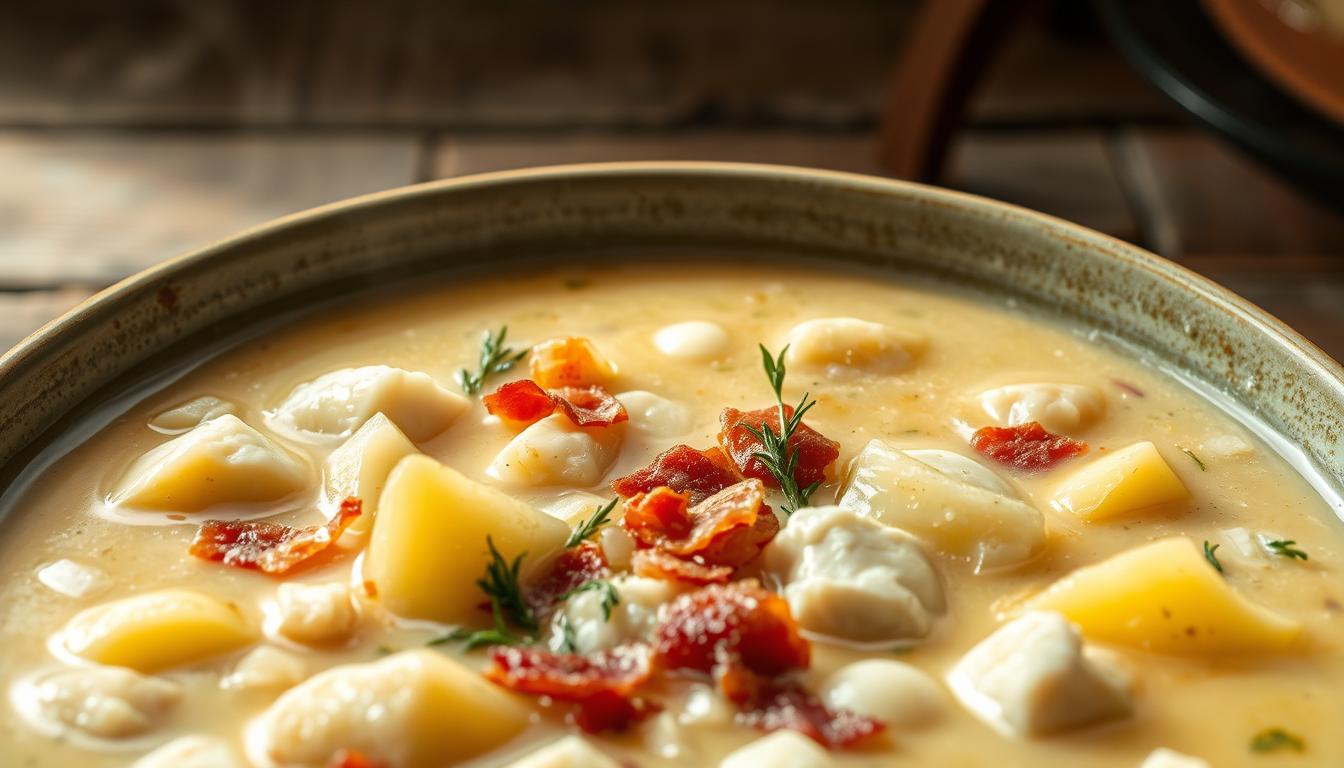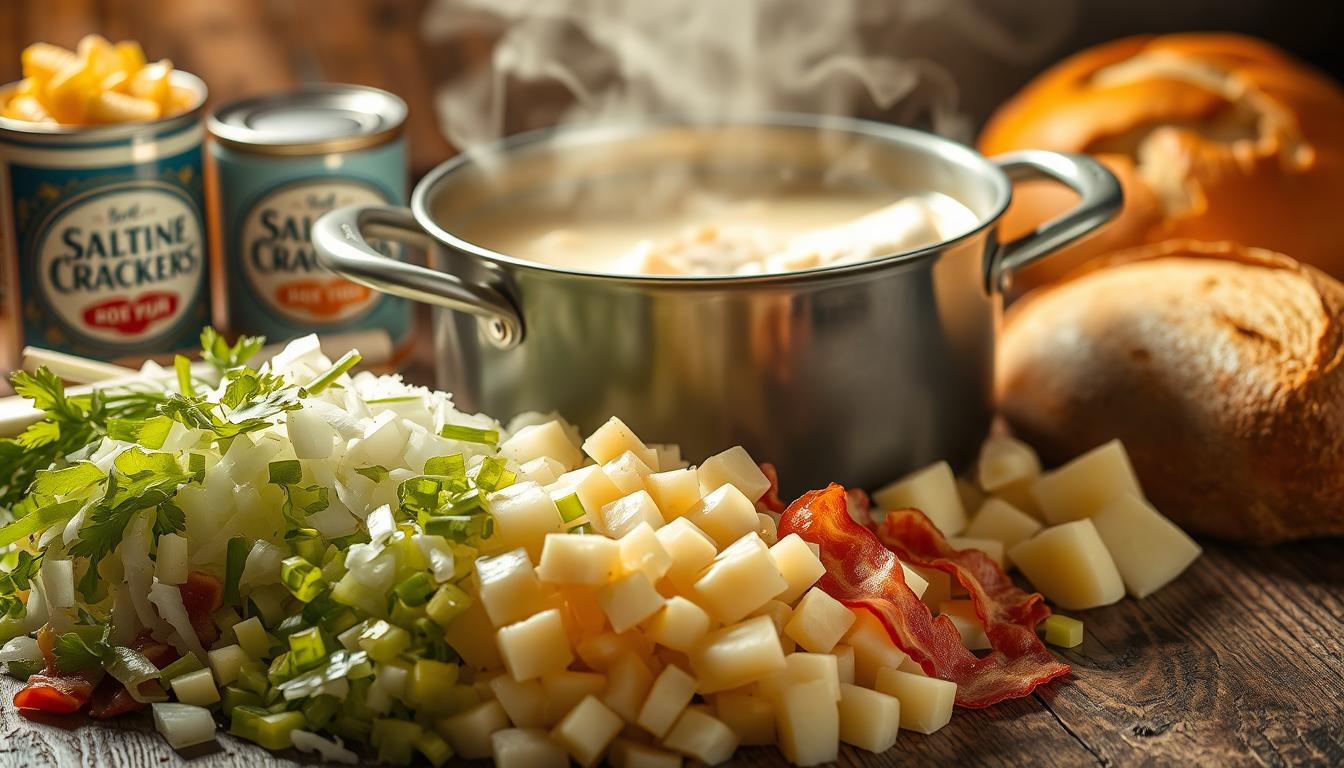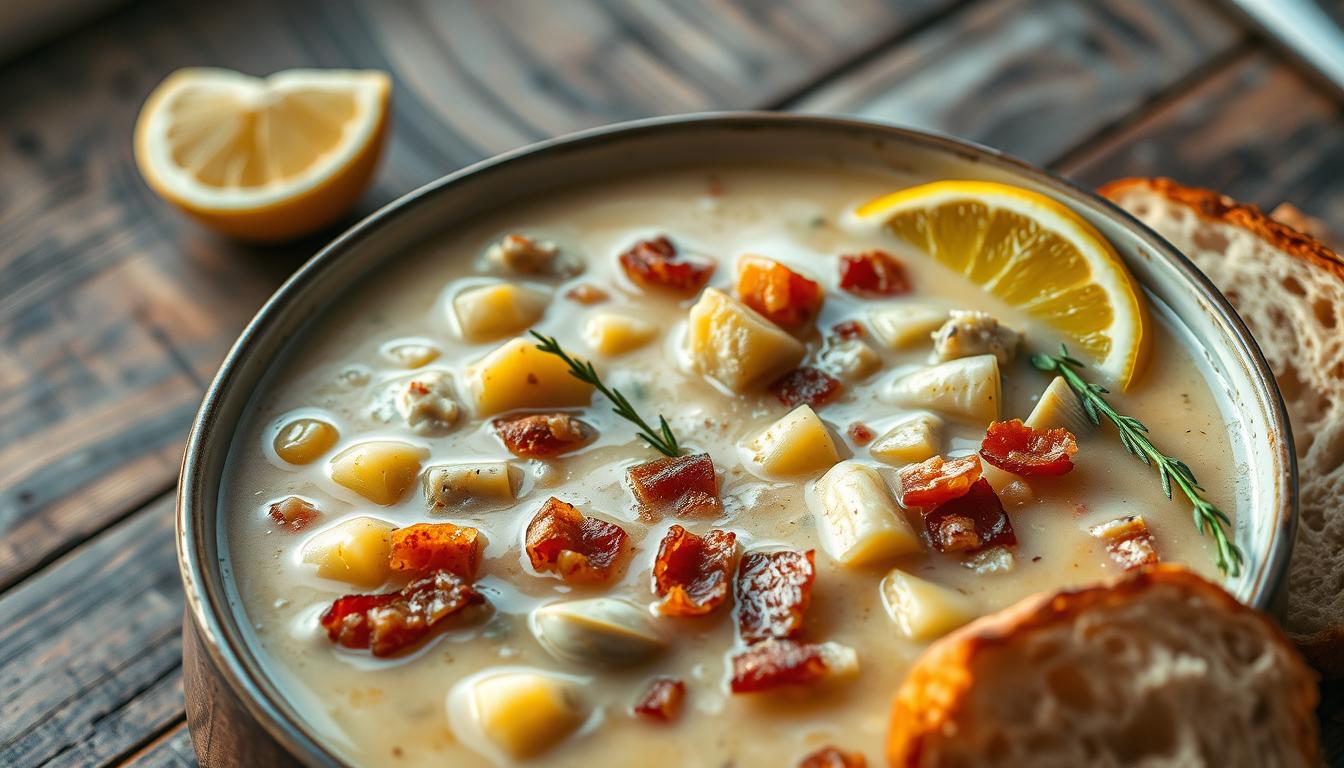Classic New England Fish Chowder
A creamy, comforting bowl of New England fish chowder! Perfect for chilly evenings and packed with rich flavors. Serve it with warm crusty bread for the ultimate treat!
Ingredients:
- 1 lb fresh white fish (cod, haddock, or halibut), cut into chunks
- 4 slices bacon, chopped
- 1 medium onion, diced
- 2 cloves garlic, minced
- 3 medium potatoes, peeled and cubed
- 2 cups fish stock or clam juice
- 1 cup whole milk
- 1 cup heavy cream
- 1 bay leaf
- 1/2 tsp dried thyme
- Salt and pepper to taste
- 2 tbsp unsalted butter
- 2 tbsp fresh parsley, chopped
Instructions:
– In a large pot over medium heat, cook the chopped bacon until crispy (about 5 minutes). Remove and set aside, leaving the bacon fat in the pot.
– Add diced onion and garlic to the pot, sautéing until soft and fragrant (about 3 minutes).
– Stir in the cubed potatoes, fish stock, bay leaf, and thyme. Bring to a boil, then reduce heat and simmer for 15 minutes until potatoes are tender.
– Add the fish chunks and let them cook gently in the broth for 5 minutes.
– Pour in the milk and heavy cream, stirring gently. Simmer for another 5 minutes without boiling.
– Remove the bay leaf, season with salt and pepper to taste, then stir in the butter for extra creaminess.
– Serve hot, garnished with crispy bacon and fresh parsley. Enjoy with crusty bread!
Prep Time: 15 minutes | Cooking Time: 30 minutes | Total Time: 45 minutes
Kcal: 380 kcal | Servings: 4 servings
The Best New England Fish Chowder: Traditional Flavors You’ll Love
What makes a great New England fish chowder? How can you make a homemade chowder that tastes like the real thing? New England clam chowder is a beloved dish in America. But, what’s the difference between fish soup and chowder?
A top-notch New England fish chowder is about the right mix of flavors and quality ingredients. It’s a dish that brings people together, enjoyed by all ages. By following a simple recipe and using the best ingredients, you can make a chowder that’s both delicious and comforting.
Key Takeaways
- Learn how to make an authentic New England fish chowder with a homemade chowder recipe
- Discover the difference between fish soup and fish chowder and the two essential ingredients required for a traditional seafood chowder
- Understand the importance of using high-quality ingredients in your New England clam chowder
- Get tips on how to balance flavors and create a delicious and comforting traditional seafood chowder
- Find out how to create a great New England fish chowder with a simple and easy-to-follow recipe
- Learn about the rich heritage and traditional flavors of New England clam chowder and how to capture them in your homemade chowder recipe
The Rich Heritage of New England Fish Chowder
New England fish chowder has a rich history, starting in colonial America. European settlers influenced it with their cooking and ingredients. This mix with New England’s fresh seafood created a tasty authentic New England cuisine.
The region’s coastal location and seafood made it perfect for fishing. This led to a best fish chowder recipe that’s both tasty and healthy.
Origins of Fish Chowder in Colonial America
At first, fish chowder was a simple dish with fish, potatoes, and local ingredients. Over time, it became a beloved comfort food recipe in New England. Each area developed its own special way of making it.
Why New England Became the Chowder Capital
Now, New England is famous for its fish chowder. Restaurants and chefs all over serve their own versions. Whether you want the traditional authentic New England cuisine or a new take on the best fish chowder recipe, you’ll find it here.
| Region | Characteristics |
|---|---|
| New England | Fresh seafood, creamy broth, potatoes |
| Other Regions | Variations in ingredients and cooking techniques |
Essential Ingredients for Authentic Fish Chowder
To make a tasty New England seafood soup, you need top-notch ingredients. The key to a great creamy fish soup is the freshness and taste of its parts. Choose sustainable seafood and local produce for the best results.
Some key ingredients for real fish chowder are:
- Fresh seafood like cod, haddock, or salmon
- Aromatic veggies like onions, celery, and carrots
- Dairy items, like heavy cream and whole milk
- Herbs and spices, such as thyme, bay leaves, and paprika
When making your New England seafood soup, the quality of your ingredients matters a lot. Choose the freshest fish and shellfish you can find. Feel free to mix different herbs and spices to make your soup unique.
Consider adding more to make your fish chowder even better. A bit of white wine or fresh lemon juice can add a nice citrus taste. A sprinkle of parsley or chives can also add a fresh flavor.
| Ingredient | Quantity | Preparation |
|---|---|---|
| Cod or haddock | 1 pound | Cut into 1-inch pieces |
| Onions | 2 medium | Chopped |
| Carrots | 2 medium | Chopped |
| Heavy cream | 1 cup | Whipped |
By using these key ingredients and following a few easy steps, you’ll make a delicious and authentic creamy fish soup. It’s sure to impress everyone.
Choosing the Perfect Fish for Your Chowder
Choosing the right fish for your new england clam chowder is key. There are many fish to pick from, making it hard to decide. For a classic homemade chowder recipe, pick a fish that’s tasty and good for the planet.
Start with popular fish like cod, haddock, and halibut. They’re firm, mild, and go well with chowder ingredients. You can use fresh or frozen fish, based on what’s in season and what you like.
Best Fish Varieties for Chowder
- Cod: A classic choice for chowder, cod has a flaky texture and a mild flavor.
- Haddock: Similar to cod, haddock has a firm texture and a slightly sweeter flavor.
- Halibut: A slightly pricier option, halibut has a rich, buttery flavor that’s perfect for chowder.
Choose fish that’s certified as sustainably sourced. This is good for the planet and ensures you get the best fish. Making these choices helps you make a tasty and eco-friendly new england clam chowder for any event.
Fresh vs Frozen Fish Options
Fresh fish is great if you can get it from a local market. But frozen fish is also good and often cheaper. Always follow food safety rules to keep your fish safe.
Sustainable Seafood Choices
Choosing sustainable seafood helps the planet and supports good fishing. Look for MSC or ASC certifications to know your fish is okay. With a bit of planning, you can make a delicious and eco-friendly homemade chowder recipe for any time.
| Fish Variety | Sustainability Rating | Flavor Profile |
|---|---|---|
| Cod | High | Mild |
| Haddock | Medium | Slightly Sweet |
| Halibut | Low | Rich, Buttery |
The Classic New England Fish Chowder Recipe
To make a delicious traditional seafood chowder, start with the best fish chowder recipe. This classic New England fish chowder is a staple for a reason. It’s hearty, flavorful, and uses the freshest ingredients.
A good traditional seafood chowder has a rich, creamy broth and tender fish. The best recipe combines fish, shellfish, and vegetables. They’re all slow-cooked in a flavorful broth.
Preparation Time and Servings
This recipe serves 4-6 people and takes about 30 minutes to prepare. It’s perfect for a weeknight dinner or a special occasion.
Required Equipment
You’ll need a large pot, a cutting board, and a knife for this recipe. Also, a blender or food processor is needed to puree the broth, if desired.
Step-by-Step Instructions
Start by sautéing onions, garlic, and fish in a large pot. Then, add the broth, milk, and seasonings. Bring to a boil, then reduce the heat and simmer for 10-15 minutes. This ensures the fish is cooked through.
For the best fish chowder, use the freshest ingredients and don’t overcook the fish. You can also add your favorite vegetables or spices to customize the recipe.
Mastering the Art of Chowder Base
A good chowder base is key to a tasty creamy fish soup. To make an authentic New England dish, focus on the base quality. Use onions and celery for depth and flavor.
High-quality fish stock is vital for a rich base. Here are some tips for a great base:
- Use a mix of fish and shellfish for complex flavors
- Add cream or milk for a creamy fish soup feel
- Try different seasonings and spices to get the right mix
In authentic New England cuisine, the base can vary. You might choose creamy or broth-based. Mastering the base lets you make a delicious creamy fish soup that honors New England’s food traditions.
With practice, you can craft your own unique chowder base. It will take your authentic New England cuisine to new heights. Whether you’re a pro chef or a home cook, the secret is to experiment and find the perfect flavor mix.
| Chowder Base Type | Description |
|---|---|
| Creamy | Rich and indulgent, made with cream or milk |
| Broth-based | Light and refreshing, made with fish stock and minimal cream |
Thickening Techniques for Perfect Consistency
Getting the right consistency in New England seafood soup is key. A thick chowder can elevate your dining experience. You can use traditional flour methods or try other thickening agents.
To balance flavors and textures, mix different ingredients. Use flour, cornstarch, or roux to make a creamy base. Choose your thickening agent based on your taste and the chowder’s consistency you want.
Traditional Flour-Based Methods
Flour is a popular choice for thickening. Mix it with water or broth to make a slurry. Add this to your chowder for thickness. But, be careful not to get lumps.
Alternative Thickening Agents
Looking for something different? Try cornstarch or roux. They can add unique flavors and textures. Use them alone or with flour for extra thickness. Just remember to adjust the amount for the right consistency.
Achieving the Ideal Texture
The perfect texture in New England seafood soup is up to you. Some like it thick and creamy, others prefer it thinner. Adjust the thickening agent to match your taste. With practice, you’ll get it just right.
Creative Substitutions and Variations
Making a homemade chowder recipe is all about exploring new flavors. You can try different fish and shellfish to find your favorite taste. Adding smoked bacon gives a rich, savory flavor. Diced bell peppers add color and sweetness.
A traditional seafood chowder has fish, shellfish, and veggies in a creamy broth. But you can make it your own by adding unique ingredients. Here are some ideas:
- Try using cod, haddock, or salmon instead of usual fish.
- Add spice with jalapenos or red pepper flakes.
- Include shrimp, mussels, or clams for a different seafood mix.
- Use carrots, potatoes, and onions for a variety of veggies.
Remember, the secret to a great chowder is to have fun and experiment. Don’t hesitate to try new things and adjust the recipe to your liking. With creativity, you can make a delicious, unique seafood chowder that will wow everyone.
Follow these tips and ideas to make a tasty, unique chowder. So, get creative and enjoy making your own traditional seafood chowder.
Troubleshooting Common Chowder Challenges
Making a tasty best fish chowder recipe can sometimes come with challenges. Whether you’re an experienced cook or just starting out, issues like a thin or watery consistency, curdling, and seasoning problems can happen. We’ve got some tips to help you fix these common issues. This way, your new england clam chowder will be rich, creamy, and full of flavor.
Some common issues that can affect your chowder include:
- Thin or watery consistency, which can be fixed by adding a little more cream or flour to thicken the mixture
- Curdling, which can be prevented by tempering the cream before adding it to the chowder
- Seasoning problems, which can be adjusted by adding more herbs, spices, or salt to taste
By following these simple tips and using a tried-and-true best fish chowder recipe, you’ll be well on your way to creating a delicious and authentic new england clam chowder. It’s sure to please even the most discerning palates.
Serving and Storage Tips
Serving and storing fish chowder right is key to keeping its taste and texture. This comfort food is best with traditional sides that match its creamy flavor.
Crusty bread, oyster crackers, or a side salad are great choices. Cool the chowder to room temperature before refrigerating or freezing. This step prevents bacterial growth and keeps the chowder fresh longer.
Traditional Accompaniments
- Crusty bread: perfect for dipping into the chowder
- Oyster crackers: adds a nice texture to the dish
- Side salad: provides a refreshing contrast to the rich chowder
Proper Storage Methods
To store fish chowder, follow these steps:
- Cool the chowder to room temperature
- Refrigerate or freeze the chowder in airtight containers
- Label and date the containers for easy identification
Reheating Guidelines
When reheating fish chowder, heat it to 165°F (74°C) for safety. You can reheat it in the microwave, on the stovetop, or in the oven. Always check the temperature before serving to ensure it’s hot and ready to eat.
By following these tips, you can enjoy your fish chowder for longer while keeping its flavor and texture.
Health-Conscious Adaptations
Want a healthier creamy fish soup? There are easy ways to do it without losing flavor. Try using low-fat cream or milk to cut down on calories and fat. Also, switch to a reduced-sodium broth to reduce sodium.
To boost nutrition, add more veggies. Onions, carrots, and celery bring fiber, vitamins, and minerals. You can also toss in diced bell peppers or zucchini for extra flavor and nutrition.
Here are some tips for a healthier fish chowder:
- Use fresh, sustainable seafood whenever possible
- Choose low-fat dairy products to reduce calorie and fat content
- Use reduced-sodium broth to lower overall sodium content
- Increase the amount of vegetables in the soup for added fiber and nutrients
With a few tweaks, you can enjoy a nutritious and tasty bowl of creamy fish soup. It’s perfect for any time of year.
“Eating a healthy and balanced diet is important for maintaining overall health and wellbeing. By making a few simple adaptations to traditional recipes, you can create delicious and nutritious meals that are perfect for any occasion.”
| Ingredient | Traditional Amount | Health-Conscious Amount |
|---|---|---|
| Dairy products | Full-fat cream and milk | Low-fat cream and milk |
| Broth | Regular sodium broth | Reduced-sodium broth |
| Vegetables | Onions, carrots, and celery | Onions, carrots, celery, and other vegetables such as bell peppers and zucchini |
Wine Pairing and Serving Suggestions
Choosing the right wine can make your traditional seafood chowder even better. A crisp white wine, like Chardonnay or Sauvignon Blanc, goes great with the best fish chowder recipe.
For a complete meal, add some side dishes. A fresh green salad or grilled bread works well. They balance the richness of the chowder and add texture.
Best Wine Selections
- Chardonnay: a buttery and oaky wine that pairs well with the creamy broth
- Sauvignon Blanc: a crisp and citrusy wine that complements the bright, seafood flavors
- Pinot Griguv: a light and refreshing wine that pairs well with the delicate flavors of the fish
Presentation Tips
To make your dish look good, garnish with fresh herbs like parsley or chives. Serving it in a rustic bread bowl or with crusty bread for dipping is also a great idea.
By using these wine pairing and serving tips, you’ll create a memorable meal. It will highlight the rich flavors of your traditional seafood chowder and best fish chowder recipe.
Conclusion
Our journey through New England fish chowder’s history and flavors has ended. We now appreciate this iconic dish more than ever. It has become a beloved comfort food in the Northeast.
Making the perfect homemade chowder recipe is all about tradition. It’s about using the right ingredients and techniques passed down through generations. Whether you like it creamy or broth-like, mastering the chowder base is key. Try different thickening methods and garnishes to make it your own.
Keep exploring New England fish chowder, but always respect its traditions. With creativity and a love for its history, you can make this dish even better. Enjoy every spoonful, and let it nourish your soul.
FAQ
What is the difference between fish soup and fish chowder?
Fish soup and fish chowder differ mainly in their texture. Fish chowder is thick and creamy. It includes milk or cream and potatoes, making it rich and hearty.
What are the essential ingredients for authentic New England fish chowder?
For real New England fish chowder, you need fresh seafood like cod or haddock. Add potatoes, onions, celery, and milk or cream. Season with salt, pepper, and thyme for the best taste.
What are the best fish varieties for making fish chowder?
The best fish for chowder are cod, haddock, halibut, and pollock. They are firm and flaky. Always choose sustainable, local fish for the best flavor.
How can I thicken my fish chowder for the perfect consistency?
To thicken your chowder, use a roux or mashed potatoes. Cornstarch or arrowroot powder are good gluten-free options. Just add a little at a time until it’s right.
What are some common challenges when making fish chowder, and how can I troubleshoot them?
Common issues include a thin chowder or curdling. For a thicker chowder, add more roux or potatoes. To avoid curdling, temper the dairy before adding it. Adjust the seasoning to fix flavor problems.
What are some creative substitutions and variations for fish chowder?
Try different fish like salmon or scallops. Add unique ingredients like smoked bacon or bell peppers. This lets you make the dish your own.
How should I serve and store fish chowder?
Serve with crusty bread or a green salad. Store it in the fridge for 3-4 days or freeze for longer. Reheat gently to keep it creamy.
Link source:
- Anchor Text: “Learn more about making the perfect seafood chowder”
Link: Seafood Recipes
(This link will provide readers with more seafood chowder recipes and helpful tips.) - Anchor Text: “Find out how to choose the best fish for chowder”
Link: Choosing Fish for Cooking
(This resource offers valuable insights on selecting the best fish for different types of dishes, including chowder.) - Anchor Text: “Discover the health benefits of an acid reflux-friendly diet”
Link: Acid Reflux Nutrition
(This link provides information about modifying recipes, including chowders, for those with acid reflux.)










